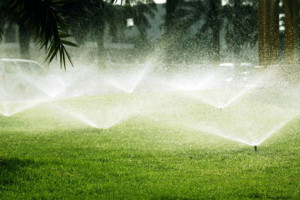
How much water does a lawn need? In general, cool-season grasses need about one to 1.5 inches of water per week to maintain green color and active growth. This allows lawns to naturally slow down in growth during extreme conditions. You may let the lawn go almost completely dormant in hot weather. Many factors such as the soil and weather all have a role in the lawn’s water needs. Here are a few guidelines to follow:
Decide before hand
Decide before summer heat and drought conditions arrive, to either water lawns consistently as needed throughout the season, or let lawns go dormant as conditions turn warm and dry. Do not rotate back and forth. In other words, don’t let the grass turn totally brown, apply enough water to green it up, then let the grass go dormant again. Breaking the lawns dormancy actually drains large amounts of food reserves from the plant.
When is it time to water?
The first few warm days of summer does not automatically mean to water lawns. In fact, allowing lawns to start to go under mild drought stress actually increases rooting. Watch for foot printing, or footprints remaining on the lawn after walking across it (instead of leaf blades bouncing back up). Grasses also tend to turn darker in color as they go under drought stress. Sampling the root zone soil could be another option.
Water as infrequently as possible
Thoroughly water when you do water so moisture soaks down to the roots. Exceptions to this general rule would be for newly seeded lawns where the surface needs to stay moist, newly sodded lawns that have not yet rooted into the soil, or when summer patch disease is a problem. Otherwise, avoid frequent waterings that promote shallower root systems and weeds (e.g., crabgrass).
Water early if possible
Given a choice, water early in the day when lawns are normally wet from dew. Avoid midday due to evaporation, and at night due to potential increased chances of some diseases. The exception to this guide is when you are in extremely hot weather and nighttime temperatures don’t go below 68 degrees. Then it is better to water in the late afternoon or early evening, providing you don’t have watering-time restrictions. Late in the day reduces the amount of evaporation that takes place during the very hot day, allowing more water to reach the root zone.
Spread the water uniformly across the lawn
Sprinklers vary in distribution patterns, and require spray overlap for uniform coverage. Placing coffee cans or similar straight-sided containers on the lawn can help measure water application rates. Avoid flooding areas, or missing other spots. On heavy clay soils and slopes, watch for excessive runoff; it may be necessary to apply the water in several applications to allow for adequate penetration.
Water conservation
To help conserve water, mow your lawn at a higher than normal height, avoid applying an excess of nitrogen as warm weather approaches, limit traffic over the lawn, improve turf rooting, control thatch and soil compaction, and avoid pesticide use on drought stressed lawns.




